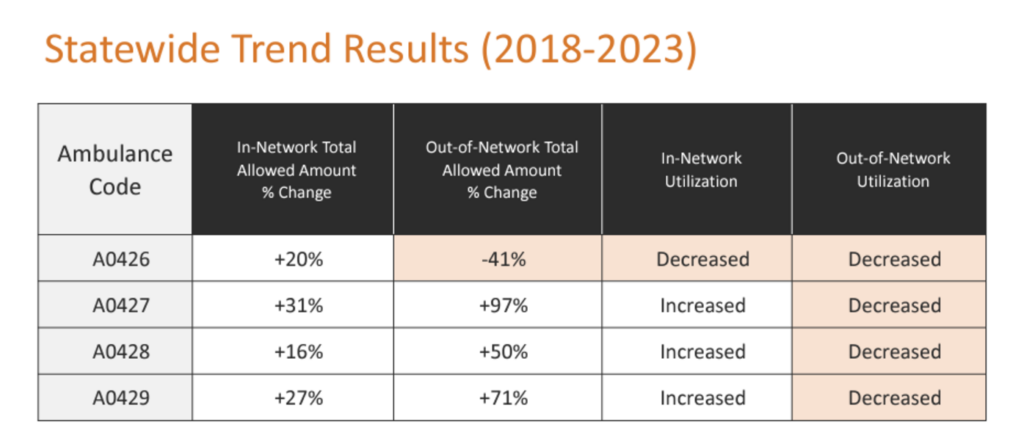A first of its kind analysis on ambulance service costs in Colorado is now available, delivering valuable insights into cost trends, in-and out-of-network claims, and geographic variation. Leveraging the CO APCD, this report sheds light on costs affecting patients and health insurance payers and informs policy discussions aimed at enhancing emergency transportation accessibility and affordability.
Colorado’s surprise billing law does not currently limit out-of-network billing for ambulance services, potentially causing significant financial burdens for patients that may receive a hefty balanced bill for services not covered under their insurance plan. This analysis helps shed light into in-network and out-of-network ambulance service costs and utilization rates to support legislative and other efforts to reduce the cost burden of ambulance costs for Coloradans.
In addition to insurance plan payments and patient payments, the analysis also compares commercial health insurance payments to Medicare Fee-for-Service (FFS) rates, often used as a benchmark to understand price variation across commercial payers.
Data Highlights Include:
- Statewide, commercial payers paid 2.5 to 3 times more than Medicare FFS rates for the most common ambulance services.
- In 2022, payments for basic life support (BLS) non-emergency services were 2.8 higher than Medicare FFS rates, and BLS emergency services were 2.4 times higher.
- For advanced life support (ALS) emergency transports, payments were 2.4 times Medicare FFS rates, with ALS non-emergency services the highest at over 3 times Medicare rates.
- Urban areas have higher commercial payments at 2.7 times Medicare FFS rates, compared to 2.4 times in rural areas, highlighting geographic disparities in ambulance costs across the state.
Below are some additional insights from the analysis:
- Across the most common ambulance codes, approximately 40-50% were in-network, and 50-60% were out-of-network. This underscores persistent challenges with network inclusivity for ambulance services.
- Total allowed amounts (patient and payer payments combined) for every ambulance service code (in-network claims), increased from 2018 to 2023. The most utilized code, advanced life support (ALS), increased by 31% from 2018 to 2023.
- The total allowed amounts for advanced life support services regularly surpassed $1,000 and were as high as $1,300 total allowed amount, marking them as the costliest services statewide. In contrast, basic life support services ranged from $300 to $1,000.
- Emergency advanced life support was the most utilized service across both in-network and out-of-network claims. Fort Collins, the West, and Grand Junction Division of Insurance regions had the highest use of these services.
CIVHC continues to prioritize transparency and actionable data to guide efforts in reducing health care costs and improving care across Colorado. The CO APCD serves as a powerful tool for understanding these trends and supporting impactful change.
For full details and to explore the complete analysis of ambulance service costs, visit https://civhc.org/get-data/publications/

